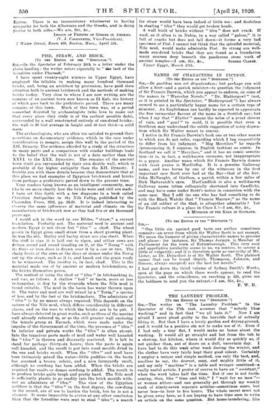PISE, STRAW, AND BRICK.
[To THE EDITOR or THE " SPECTATOR."] SIR,—In the Spectator of February 28th is a letter under the above heading : the writer refers especially to " the task of the Israelites under Pharaoh."
I have spent twenty-eight winters in Upper Egypt, have employed the fellahin in making many hundred thousand bricks, and, being an architect by profession, have -paid close attention both to ancient brickwork and the-methods of making bricks to-day. Very close to where I am now writing are the remains of an ancient town now known as El Kab, the history of which goes back to the prehistoric period. There are many remains of this town. Much of this town was, at a period somewhat disputed by archaeologists (who love to make out that every place they study is of the earliest possible date), surrounded by a wall constructed entirely of sun-dried bricks: the wall is 30 feet average in height and 40 feet thick—a solid
mass.
The archaeologists, who are often too satisfied to ground their assertions on documentary evidence, which in the case under consideration is meagre, assign this wall to the period of the XII. Dynasty. The evidence afforded by a study of the structure in many parts and a comparison with similar buildings leads to the belief that the wall is not of a date earlier than the XXVI. to the XXX. Dynasties. The remains of the ancient town itself are surrounded by their own double wall, which is probably of far higher antiquity than the XII. Dynasty. I trouble you with these details because they demonstrate that at this place we find examples of Egyptian brickwork and bricks from perhaps a prehistoric period down to the present time.
Your readers being known as an intelligent community, may like to see more clearly how the bricks were and still are made. I have set this forth with a few diagrams in a book called Christian Antiquities in the Nile Valley, published by the Clarendon Press, 1912, pp. 23-31. It is indeed interesting to observe the same influences of material and climate on the manufacture of brickwork now as they had five or six thousand years ago.
1 would ask is the word in our Bibles, " straw," a correct translation. Probably not. The material used in ancient and modern Egypt is not straw but " tibu " = chaff. The wheat grown in Egypt gives small straw from a short growing plant. So was the old. Barley and barley straw are also short. When the stuff is ripe it is laid out to ripen, and either cows are driven round and round treading on it, or the " Noreg " with its flints or iron discs is drawn over it by a cow or two. The sharp hoofs of the cows or the discs or stones under the Noreg cut up the straw, such as it is, and knock out the grain ready to be winnowed. The residue is, in fact, chaff. This is the material made use of by ancient or modern brickmakers, as the bricks themselves prove.
The method of using the chaff or " tibu " in brickmaking is, and was, as follows. A shallow "hod" or basin, more or less rectangular, is dug by the riverside where the Nile mud is found suitable. The mud in the basin has water thrown upon it. The water and mud are well mixed by a " Toria," a species of hoe, and by the feet of the brickmakers. The admixture of '!tibu" is by no means always required. This depends on the nature of the Nile mud, which differs considerably in different places, and on the uses to which the bricks are to be put. I have always detected in great works, such as those of the marine wall already referred to, or as the still greater wall enclosing the temple group at Karnak, which were made under the impulse of the Government of the time, the presence of " tibu." In inferior and private works the "film" is often absent. Into the tenacious paste made of mud and water well kneaded the " tibu " is thrown and discreetly scattered. It is left to stand for perhaps thirty-six hours; then the paste is again well kneaded, and the result is put into wood moulds dried in the sun and bricks result. When the "tibu" and mud have been intimately mixed the water—little puddles—in the basin has assumed a brown colour, and a nice farmyardy smell, although no cowdung has been added. When the bricks are required for vaults or domes cowdung is added. The result is to produce bricks quite tough and pretty hard. The Nile mud is sufficiently plastic to go readily into the brick moulds with- out an admixture of " tibu." The view of the Egyptian artificer is that the " tibu" in the first degree, the cow-dung in the second, are of use to harden the brick, but he is not a chemist. It seems impossible to arrive at any other conclusion than that the Israelites were sent to steal " tibu"; a search for straw would have been indeed of little use : and doubtless in stealing " tibu" they would get broken heads.
A wall built of bricks without "tibu" does not crack. If used, as it often is in Nubia, in a way called " galoos," it is full of cracks but does not fall down—it forms a very bad specimen of Pis& I cannot but think that the splendid material, Nile mud, would make admirable Piet So strong are well- made sun-dried bricks that they are found as a foundation many courses deep beneath the ponderous stone work Of
ancient temples.—I am, Sir, &c., SOMERS CIAREN. Upper Egypt, March 17th.


































 Previous page
Previous page